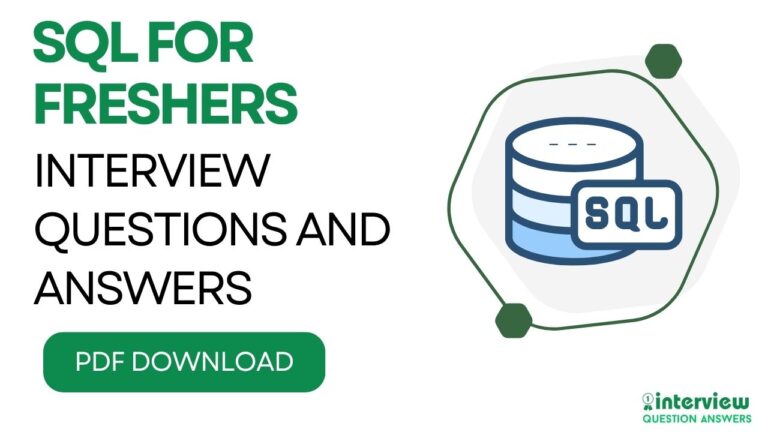Top 50 Data Analyst Interview Questions for Freshers 2025
Starting as a fresher data analyst means turning raw data into actionable insights using tools like SQL, Excel, Python, and Tableau. Companies across industries, from e-commerce to finance, rely on data analysts to optimize operations, predict trends, and drive decisions, making this role highly in demand with strong salary potential. However, landing your first job requires more than just technical knowledge, it’s about proving you can solve real-world problems.
This guide covers the most asked data analyst interview questions for freshers, including SQL queries, Excel functions, statistical concepts, data visualization, and case studies. Mastering these topics helps you stand out in interviews, avoid common mistakes, and showcase your analytical skills with confidence. This resource ensures you’re ready to ace your Data Analyst Freshers interview and kickstart a rewarding career in data analytics.
You can also check another guide here: Data Analyst Interview Questions and Answers PDF
Basic Data Analyst Interview Questions for Freshers
Que 1. What is the role of a Data Analyst?
Answer: A Data Analyst collects, processes, and analyzes data to provide actionable insights that support business decisions. They use tools like Excel, SQL, and Python to clean data, create reports, and visualize trends, helping organizations optimize processes or strategies. For freshers in 2025, understanding business context and communicating findings clearly is key.
Que 2. What is the difference between data analysis and data science?
Answer:
| Aspect | Data Analysis | Data Science |
|---|---|---|
| Focus | Descriptive insights | Predictive, prescriptive models |
| Tools | Excel, SQL, Tableau | Python, R, machine learning |
| Scope | Current/historical data | Future predictions, algorithms |
Data analysis focuses on interpreting existing data, while data science includes advanced modeling.
Que 3. What is data cleaning, and why is it important?
Answer: Data cleaning involves removing or correcting errors, duplicates, or missing values in datasets to ensure accuracy. It’s important because clean data improves the reliability of analysis and prevents misleading conclusions.
Que 4. How do you use Excel for data analysis?
Answer: Excel is used for data analysis through functions like VLOOKUP, pivot tables, and charts. For example, pivot tables summarize data, and conditional formatting highlights trends. For freshers, mastering Excel’s filtering and sorting features is essential.
Example:
=SUM(A1:A10) // Calculates sum of a rangeQue 5. What is a pivot table, and how do you create one in Excel?
Answer: A pivot table summarizes and analyzes data, allowing grouping and aggregation. To create one, select data, go to Insert > Pivot Table, choose fields to analyze, and drag them to rows/columns/values. For freshers, it’s used to explore sales or customer data.
Que 6. What is SQL, and why is it important for data analysts?
Answer: SQL (Structured Query Language) is used to query and manage databases. It’s important for extracting, filtering, and aggregating data efficiently from large datasets, enabling analysts to derive insights.
Que 7. How do you write a basic SQL SELECT query?
Answer: A SELECT query retrieves data from a database table.
Example:
SELECT name, age FROM customers WHERE age > 25;This query selects names and ages of customers over 25.
Que 8. What is the difference between WHERE and HAVING clauses in SQL?
Answer: WHERE filters rows before aggregation, while HAVING filters groups after aggregation (e.g., with GROUP BY). For freshers, understanding their order in query execution is key.
Example:
SELECT department, COUNT(*) FROM employees GROUP BY department HAVING COUNT(*) > 10;Que 9. What are descriptive statistics, and what are some common measures?
Answer: Descriptive statistics summarize data using measures like:
- Mean: Average value.
- Median: Middle value.
- Mode: Most frequent value.
- Standard Deviation: Spread of data.
For freshers, these are calculated in Excel or Python for data summaries.
Que 10. How do you handle missing data in a dataset?
Answer: Handle missing data by:
- Removing rows/columns with missing values (if minimal).
- Imputing with mean, median, or mode.
- Using algorithms to predict missing values.
For freshers, tools like Excel’s IFERROR or Python’s pandas are practical.
Que 11. What is data visualization, and why is it important?
Answer: Data visualization presents data in graphical formats like charts or dashboards to reveal patterns and trends. It’s important for communicating insights to non-technical stakeholders effectively.
Que 12. What is Tableau, and how is it used in data analysis?
Answer: Tableau is a data visualization tool used to create interactive dashboards and reports. Analysts connect to data sources, drag fields to build visuals, and share insights. For freshers, mastering basic charts like bar or line graphs is a starting point.
Que 13. How do you create a bar chart in Tableau?
Answer: In Tableau, connect to a dataset, drag a categorical field (e.g., region) to Columns and a numerical field (e.g., sales) to Rows, then select Bar from the Marks menu. For freshers, adding filters enhances interactivity.
Que 14. What is the difference between a JOIN and a UNION in SQL?
Answer:
| Operation | Purpose | Example Output |
|---|---|---|
| JOIN | Combines columns from tables | Matches rows by key |
| UNION | Combines rows from tables | Stacks rows, removes duplicates |
Example:
SELECT name FROM table1 UNION SELECT name FROM table2;Que 15. How do you use Python’s pandas library for data analysis?
Answer: Pandas is used for data manipulation, like filtering, grouping, or merging datasets. For example, df.groupby('column').sum() aggregates data. For freshers, learning pandas’ DataFrame operations is essential.
Example:
import pandas as pd
df = pd.read_csv('data.csv')
print(df['sales'].mean())Que 16. What is a primary key in a database?
Answer: A primary key is a unique identifier for each record in a database table, ensuring no duplicates and enabling efficient data retrieval. For freshers, understanding its role in joins is important.
Que 17. How do you calculate the mean and median in Python?
Answer: Use pandas or NumPy for calculations.
Example:
import pandas as pd
data = [1, 2, 3, 4, 5]
df = pd.Series(data)
print(df.mean()) # Outputs: 3.0
print(df.median()) # Outputs: 3.0Que 18. What is the purpose of a GROUP BY clause in SQL?
Answer: The GROUP BY clause groups rows with identical values in specified columns, used with aggregate functions like COUNT or SUM.
Example:
SELECT department, SUM(salary) FROM employees GROUP BY department;Que 19. How do you identify outliers in a dataset?
Answer: Identify outliers using:
- Statistical methods: Values beyond 1.5 * IQR (Interquartile Range).
- Visualization: Box plots in Tableau or Python’s matplotlib.
For freshers, removing or capping outliers ensures accurate analysis.
Que 20. What is the difference between correlation and causation?
Answer: Correlation measures the relationship between two variables (e.g., using Pearson’s coefficient), but causation implies one variable directly affects another. For freshers, avoiding assumptions of causation without evidence is critical.
Que 21. How do you use Power BI for data analysis?
Answer: Power BI connects to data sources, transforms data using Power Query, and creates interactive dashboards. For freshers, building simple visuals like pie charts or slicers is a starting point for stakeholder reports.
Que 22. What is a subquery in SQL, and when is it used?
Answer: A subquery is a query nested within another query, used to filter or compute intermediate results.
Example:
SELECT name FROM customers WHERE id IN (SELECT id FROM orders WHERE amount > 1000);For freshers, subqueries simplify complex filtering.
Que 23. How do you perform data aggregation in pandas?
Answer: Use pandas’ groupby() with functions like sum(), mean(), or count() to aggregate data.
Example:
import pandas as pd
df = pd.DataFrame({'dept': ['HR', 'IT', 'HR'], 'salary': [50000, 60000, 55000]})
print(df.groupby('dept')['salary'].mean())Que 24. What is the purpose of a histogram in data analysis?
Answer: A histogram visualizes the distribution of numerical data, showing frequency of values in bins. It’s used to identify patterns like skewness or outliers, created in tools like Tableau or Python’s matplotlib.
Que 25. How do you communicate complex data insights to non-technical stakeholders?
Answer: Simplify insights using clear visuals (e.g., bar charts in Tableau), avoid jargon, and focus on business impact. For freshers in 2025, preparing concise reports in PowerPoint or Power BI and practicing storytelling ensures effective communication.

Also Check: Business Analyst Interview Questions for Experienced
Advanced Data Analyst Interview Questions for Freshers
Que 26. What is the difference between INNER JOIN and OUTER JOIN in SQL?
Answer: INNER JOIN returns only matching rows from both tables, while OUTER JOIN (LEFT, RIGHT, or FULL) includes unmatched rows from one or both tables.
| JOIN Type | Description |
|---|---|
| INNER JOIN | Matching rows from both tables |
| LEFT OUTER JOIN | All from left table, matching from right |
| RIGHT OUTER JOIN | All from right table, matching from left |
| FULL OUTER JOIN | All rows from both tables |
Example:
SELECT a.id, b.name FROM tableA a INNER JOIN tableB b ON a.id = b.id;Que 27. How do you handle duplicates in a dataset using Python’s pandas?
Answer: Use pandas’ drop_duplicates() to remove duplicates, specifying subsets of columns if needed. For freshers in 2025, checking for duplicates with duplicated() first ensures data integrity.
Example:
import pandas as pd
df = pd.DataFrame({'A': [1, 1, 2], 'B': [3, 3, 4]})
df = df.drop_duplicates(subset=['A'])
print(df) # Outputs unique rowsQue 28. What is hypothesis testing, and what are the steps involved?
Answer: Hypothesis testing determines if there’s evidence to reject a null hypothesis using statistical methods. Steps include:
- Formulate null (H0) and alternative (H1) hypotheses.
- Choose significance level (e.g., 0.05).
- Compute test statistic (e.g., t-test).
- Determine p-value and decide to reject or fail to reject H0.
For freshers, understanding p-value interpretation is crucial for data-driven decisions.
Que 29. How do you perform a LEFT JOIN in SQL, and when is it used?
Answer: A LEFT JOIN returns all rows from the left table and matching rows from the right, with NULLs for non-matches. It’s used when you need all records from one table regardless of matches.
Example:
SELECT customers.name, orders.amount
FROM customers
LEFT JOIN orders ON customers.id = orders.customer_id;Que 30. What is the purpose of the GROUP BY clause with aggregate functions in SQL?
Answer: GROUP BY groups rows by column values, used with aggregates like SUM, COUNT, AVG to summarize data.
Example:
SELECT department, AVG(salary) AS avg_salary
FROM employees
GROUP BY department;Que 31. How do you detect and handle outliers in Python using pandas?
Answer: Detect outliers using the IQR method: calculate Q1 and Q3, then identify values outside 1.5 * IQR. Handle by removing, capping, or transforming them.
Example:
import pandas as pd
df = pd.DataFrame({'values': [1, 2, 3, 100]})
Q1 = df['values'].quantile(0.25)
Q3 = df['values'].quantile(0.75)
IQR = Q3 - Q1
df = df[(df['values'] >= (Q1 - 1.5 * IQR)) & (df['values'] <= (Q3 + 1.5 * IQR))]Que 32. What is a correlated subquery in SQL, and how does it differ from a regular subquery?
Answer: A correlated subquery references columns from the outer query, executing for each row of the outer query, while a regular subquery runs independently.
Example:
SELECT name FROM employees e
WHERE salary > (SELECT AVG(salary) FROM employees WHERE department = e.department);Que 33. How do you merge two DataFrames in pandas?
Answer: Use pandas’ merge() function, specifying keys and join type (inner, outer, left, right).
Example:
import pandas as pd
df1 = pd.DataFrame({'id': [1, 2], 'name': ['A', 'B']})
df2 = pd.DataFrame({'id': [1, 3], 'score': [80, 90]})
merged = pd.merge(df1, df2, on='id', how='outer')
print(merged)Que 34. What is the p-value in hypothesis testing, and how do you interpret it?
Answer: The p-value measures the probability of observing data as extreme as the sample, assuming the null hypothesis is true. If p-value < significance level (e.g., 0.05), reject the null. For freshers in 2025, it indicates evidence against the null, not proof.
Que 35. How do you use the HAVING clause in SQL?
Answer: The HAVING clause filters groups created by GROUP BY, based on aggregate conditions.
Example:
SELECT department, COUNT(*) AS count
FROM employees
GROUP BY department
HAVING COUNT(*) > 5;Que 36. What is data normalization, and why is it used?
Answer: Data normalization scales features to a standard range (e.g., 0-1) to improve model performance in machine learning. It’s used to prevent features with larger ranges from dominating others.
Que 37. How do you create a scatter plot in Python using matplotlib?
Answer: Use matplotlib’s scatter() function to visualize relationships between two variables.
Example:
import matplotlib.pyplot as plt
x = [1, 2, 3, 4]
y = [10, 20, 25, 30]
plt.scatter(x, y)
plt.show()Que 38. What is the difference between COUNT(*) and COUNT(column) in SQL?
Answer: COUNT(*) counts all rows, including NULLs, while COUNT(column) counts non-NULL values in that column.
Example:
SELECT COUNT(*) AS total_rows, COUNT(salary) AS non_null_salaries FROM employees;Que 39. How do you pivot data in pandas?
Answer: Use pandas’ pivot_table() to reshape data, specifying index, columns, and aggregation.
Example:
import pandas as pd
df = pd.DataFrame({'date': ['2025-01', '2025-01'], 'city': ['NY', 'LA'], 'sales': [100, 200]})
pivot = df.pivot_table(values='sales', index='date', columns='city', aggfunc='sum')
print(pivot)Que 40. What is A/B testing, and how is it conducted?
Answer: A/B testing compares two versions (A and B) to determine which performs better. Conduct by randomly assigning users to groups, measuring metrics (e.g., conversion rate), and using statistical tests to analyze results. For freshers in 2025, tools like Google Optimize simplify implementation.
Que 41. How do you use subqueries in SQL for filtering?
Answer: Subqueries filter data by nesting queries, e.g., in WHERE for correlated subqueries.
Example:
SELECT name FROM products WHERE price > (SELECT AVG(price) FROM products);Que 42. What is feature engineering in data analysis?
Answer: Feature engineering creates new variables from existing data to improve model performance, e.g., deriving “age group” from “age.” It involves scaling, encoding, or creating interactions. For freshers, it’s key in preparing data for machine learning.
Que 43. How do you create a heatmap in Python using seaborn?
Answer: Use seaborn’s heatmap() to visualize correlations or matrices.
Example:
import seaborn as sns
import pandas as pd
df = pd.DataFrame({'A': [1, 2], 'B': [3, 4]})
sns.heatmap(df.corr())Que 44. What is the purpose of the ORDER BY clause in SQL?
Answer: The ORDER BY clause sorts query results by one or more columns, ascending (ASC) or descending (DESC).
Example:
SELECT name, salary FROM employees ORDER BY salary DESC;Que 45. How do you handle categorical data in Python for analysis?
Answer: Handle categorical data by encoding (e.g., one-hot with pandas’ get_dummies()) or label encoding for ordinal variables.
Example:
import pandas as pd
df = pd.DataFrame({'color': ['red', 'blue']})
df = pd.get_dummies(df, columns=['color'])
print(df)Que 46. What is time series analysis, and what is a common tool for it?
Answer: Time series analysis examines data points over time to identify trends or forecasts, used in stock prices or sales. A common tool is Python’s pandas for resampling or ARIMA models in statsmodels.
Que 47. How do you calculate correlation in Python?
Answer: Use pandas’ corr() method to compute correlation coefficients between variables.
Example:
import pandas as pd
df = pd.DataFrame({'A': [1, 2, 3], 'B': [4, 5, 6]})
print(df.corr())Que 48. What is the LIMIT clause in SQL, and how is it used?
Answer: The LIMIT clause restricts the number of rows returned by a query, useful for pagination.
Example:
SELECT * FROM products ORDER BY price DESC LIMIT 10;Que 49. How do you resample time series data in pandas?
Answer: Use pandas’ resample() to aggregate time series data by frequency (e.g., daily to monthly).
Example:
import pandas as pd
df = pd.DataFrame({'date': pd.date_range('2025-01-01', periods=10), 'value': range(10)})
df.set_index('date', inplace=True)
monthly = df.resample('M').sum()
print(monthly)Que 50. What is the difference between supervised and unsupervised learning in data analysis?
Answer: Supervised learning uses labeled data to train models (e.g., regression), while unsupervised learning finds patterns in unlabeled data (e.g., clustering). For freshers in 2025, supervised is common for prediction tasks.
Conclusion
We have already shared the essential questions for Data Analyst Interview Questions for Freshers. This comprehensive Data Analyst Guide includes interview questions for fresh graduates, covering both basic and advanced questions that employers commonly evaluate. The data analytics industry is rapidly evolving with AI integration, cloud platforms, and real-time processing becoming standard requirements.
These Data Analyst Interview Questions for Freshers provide the foundation needed to succeed in your job search, covering technical skills from SQL to statistical analysis. With proper preparation using these Data Analyst Interview Questions for Freshers and understanding current industry demands, you’ll be well-positioned to launch your data analytics career.
Related Interview Guides:













